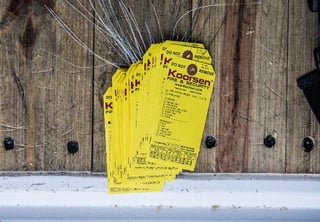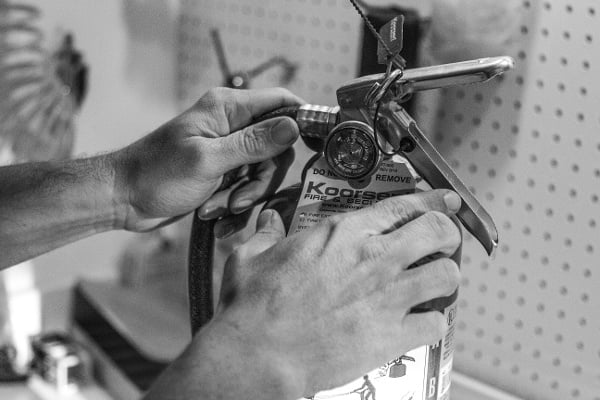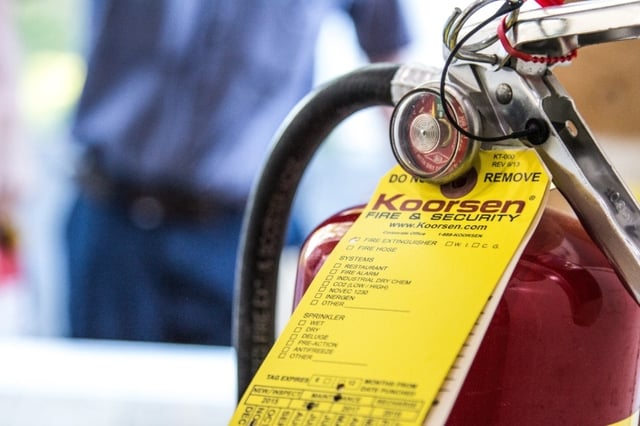Changes to the 2018 Edition of NFPA 10 – Standard for Portable Fire Extinguishers
NFPA 10 provides standards that apply to the selection, installation, inspection, maintenance, recharging, and testing of portable fire extinguishers. The latest edition of the Code is 2018 which was issued on August 1, 2017 and went into effect on August 21, 2017.
In this latest edition, you’ll find many new changes and updates including clarifications on electronic monitoring, obsolete extinguishers, extinguishers in areas containing oxidizers, extinguisher signs, and mounting equipment and cabinets. A new requirement regarding maintenance of hose stations which are used in lieu of extinguishers has also been added.
Below, we go over the major revisions and newest additions to the 2018 edition. If you would like more clarification or have questions regarding your portable fire extinguishers at your business or residence, contact a Koorsen Fire & Security expert online or call them at 1.88.456.8038. Koorsen Fire & Security has been installing, inspecting, testing and maintaining fire extinguishers for businesses of all sizes since 1946.
Newest Additions and Revisions to NFPA 10 - 2018 Edition
Section 4.4 Obsolete Fire Extinguishers.
This section covers obsolete fire extinguishers that should be removed from service. The list was revised to include all extinguishers manufactured prior to 1955. Prior editions limited this to stored pressure fire extinguishers only.
Section 4.4.1 Obsolete Fire Extinguishers (cont.)
This section was revised to state that all dry chemical stored-pressure extinguishers with an indicated manufacturing date of 1984 or prior shall be immediately removed from service.
Section 5.5.7 Areas Containing Oxidizers.
Further guidance on portable extinguishers in areas containing oxidizers has been added in this latest edition. This new section states that fire extinguishers in areas containing oxidizers or where oxidizers are used shall be selected and installed based on the specific recommendations contained within the safety data sheet (SDS) for the oxidizer, surrounding conditions, and NFPA 400.
Section 6.1.3.3 Visual Obstructions.
There have been several revisions in this section regarding visual obstructions of fire extinguishers. Fire extinguishers should be installed in locations where they are visible. In locations where visual obstructions cannot be avoided, signs or other means shall be provided to indicate the fire extinguisher location. The signs or other means should be located in close proximity to the extinguisher.
Section 6.1.3.4 Installation of Portable Fire Extinguishers.
Due to fire extinguishers being placed in general use cabinets and other business storage, the newest addition of NFPA 10 states that portable extinguishers shall be installed in four approved ways.
A fire extinguisher may be installed securely on a hanger intended for the extinguisher, in a bracket featuring straps or bands supplied by the extinguisher manufacturer, in a listed bracket with straps or band approved for such purpose, or in approved cabinets or wall recesses. Hangers and brackets shall not be fabricated in the field.
Section 6.1.3.10 Cabinets.
To protect the integrity of fire-resistance-rated walls, the committee added two new additions to this section that states in 6.1.3.10.6 that for fire-resistance-rated walls, only surface-mounted fire extinguisher cabinets or listed fire-rated fire extinguisher cabinets shall be installed. It then states that the provisions of 6.1.3.10.6 shall not apply to existing installations.
Section 7.2.2 Inspection Procedures
Two new additions were made to this section regarding the method of fire extinguisher inspection. While the owner or the owner’s agent shall determine the method of extinguisher inspection such as manual inspection, electronic monitoring, or any combination of the two; any method other manual inspection shall require the approval of the authority having jurisdiction.
Section 7.3 Extinguisher Maintenance

The committee made an addition to the standards for maintenance procedures by stating that fire extinguishers shall be subjected to maintenance at an interval of not more than 1 year, at the time of hydrostatic test, or when specifically indicated by an inspection discrepancy or electronic notification.
Section 7.5 Hose Station Maintenance
In section 6.2.1.4, a certain number of fire extinguishers installed for Class A hazards may be replaced by hose stations according to the standards in 6.2 and the accompanying table. While 6.2.1.4 is an existing section, the committee added section 7.5 to state that the maintenance of hose stations shall be maintained in accordance with NFPA 1962.
Contact Koorsen for All Your Fire Extinguisher Needs
Whether you need fire extinguishers refilled, extinguishers inspected & tagged, new extinguishers installed, fire extinguisher training, or extinguishers due for their hydrostatic testing, contact Koorsen Fire & Security online today or call them at 1.888.456.8038.





